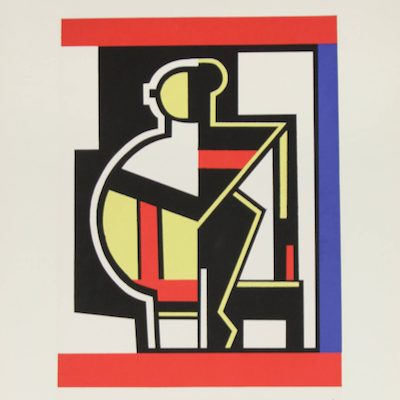
Details
Artist
Styles
Etching and aquatint in colours, on BFK Rives paper, with full margins. - This work is from the UNITÉ book, which began to be printed in 1963 and ended on October 15, 1965 in Paris. - I. 41.5 x 31.5 cm (16 3/8 x 12 3/8 in.) - S. 57 x 45.2 cm (22 1/2 x 17 3/4 in.) - Signed and numbered in pencil, from the edition of 130 pc + 30 in Roman numerals, published by Atelier Crommelynck, Paris - Edition number 63/130 // Le Corbusier’s Unité 4 (1963-1965) is a limited-edition etching and aquatint in colors, printed on BFK Rives paper. The composition features abstract and figurative elements, such as a large hand-like form holding an object, alongside geometric shapes. The upper portion includes a pattern of interlocking shapes resembling layered hands or tools in a brown hue. The central figure is framed within a rectangular panel, lending a sense of structure to the otherwise fluid and organic forms. The use of earthy tones, such as brown and beige, contrasts with bright accents, creating a balanced yet dynamic visual experience. This piece reflects Le Corbusier's exploration of human form in relation to space and object.
Unité 4, 1963-1965
form
Medium
Size
57 x 45.2 cm
- Inches
- Centimeters
Edition
Price
- USD
- EUR
- GBP
Details
Artist
Styles
Etching and aquatint in colours, on BFK Rives paper, with full margins. - This work is from the UNITÉ book, which began to be printed in 1963 and ended on October 15, 1965 in Paris. - I. 41.5 x 31.5 cm (16 3/8 x 12 3/8 in.) - S. 57 x 45.2 cm (22 1/2 x 17 3/4 in.) - Signed and numbered in pencil, from the edition of 130 pc + 30 in Roman numerals, published by Atelier Crommelynck, Paris - Edition number 63/130 // Le Corbusier’s Unité 4 (1963-1965) is a limited-edition etching and aquatint in colors, printed on BFK Rives paper. The composition features abstract and figurative elements, such as a large hand-like form holding an object, alongside geometric shapes. The upper portion includes a pattern of interlocking shapes resembling layered hands or tools in a brown hue. The central figure is framed within a rectangular panel, lending a sense of structure to the otherwise fluid and organic forms. The use of earthy tones, such as brown and beige, contrasts with bright accents, creating a balanced yet dynamic visual experience. This piece reflects Le Corbusier's exploration of human form in relation to space and object.
- Recently Added
- Price (low-high )
- Price (high-low )
- Year (low-high )
- Year (high-low )
What is Cubism?
Cubism is an art movement that aimed to depict multiple perspectives of objects or figures within a single picture. Artists Georges Braque and Pablo Picasso pioneered this style around 1907. The name Cubism emerged from their use of geometric shapes and outlines that often resembled cubes, breaking objects down into abstracted forms.



























